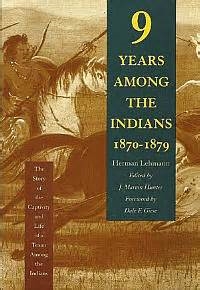Herman Lehmann
Herman Lehman was born in Mason County, Texas in 1859, to Ernst Morita and Augusta Lehmann.
They had emigrated from Prussia, arriving on the Louise in Galveston, Texas in 1846.
At the age of 1o, Herman Lehmann was captured by Apaches near his home in Mason County, Texas.
Being told his entire family was dead, “En Da” (white boy) was trained as an Apache, even forgetting his own language.
While he was with the Apaches on a raid into Mason and Gillespie Counties in 1875, Captain D. W. Roberts’ company of Rangers caught up with them and a fierce fight ensued.
Lehmann fought bravely, but was caught under a fallen horse.
Recognizing he was a “white boy,” two Rangers chased after and shot the other Indian.
When they returned, Lehmann was missing, having crawled into high grass. He made his way back to his tribe, some 300 miles away.
He next became negatively involved with an important medicine man who he slew with his bow and arrow, after which he went into hiding for a year in the mountains.
Afterwards, he went to a Comanche tribe and was adopted and given the name, “Montecca.”
Lehmann remained there until the Comanche were placed on a reservation in Oklahoma.
Lehmann was the last to surrender. When he was discovered to be “white,” he was persuaded to “return to his people” by Comanche Chief Quanah Parker.
Herman Lehmann was returned, under Texas Ranger guard, to Mason County, Texas, where he was reunited with his mother and siblings.
Slowly, memories returned of his childhood, and he became part of the Loyal Valley settlement as a good citizen.
In 1901, when the Comanche were given their allotments in the Indian Territory, Lehmann was placed on the tribal rolls and given his own allotment. He was granted 160 acres in Garfield, Oklahoma, which he gave to a school.
Herman Lehmann became a popular figure at County Fairs and Rodeos.
He wrote a popular book: Nine Years among the Indians, 1870-1879.
In 1924, at an Old Trail Drivers reunion in San Antonio, Texas, Captain J. B. Gilbert and Herman Lehmann met for the first time since their encounter 50 years earlier.
They discussed all the phases of their battle and compared notes closely. Both were fully satisfied that each had taken part in the combat.
Family
Hermann Lehmann married N. E. Burke in 1885, which ended in divorce.
He later married Fannie Light.
Together they had five children: Henry, John, Amelia, May, and Caroline.
Hermann Lehmann passed away in 1932.
“He says truthfully that he thought that it was his mission in life to kill and steal; that Indians taught him to do these awful things. But now he knows that it was wrong and no amount of provocation or under any circumstances could he be induced to shed his fellowman’s blood.”
— Frontier Times, February 1925
Source
- “Lehmann, the Indian: Oklahoma, 1870s, from Frontier Times, February, 1925,” Western States Jewish History 36/3.
Special Note: For years there have been arguments as to whether or not Herman Lehmann was Jewish. Below is correspondence with a member of a later generation:
I understand the assumption – especially with names like Moritz & Moshe in the family.
Our family is part of the one that contributed to the building of one of the largest still-surviving wooden churches – The Church of the Visitation in Westphalia, Texas (built in the 1880s), with my father adding to that construction when he made a cross for one of the steeples…
I know that my grandmother (his niece) had been in the 3rd generation of families that had several siblings join the priesthood or become nuns – that would place Herman Lehmann as part of one of those initial generations that were actively taking religious vocations. There are cousins on that side of the family who are still active in their vocation.
I know that’s less than you expected, but I am not the one with the access to the family records – as most families go, there has been some distance between us all in recent generations…
With that, I know we’re getting close to the Purim season- Chag Purim Sameach.
MDZ
HERMAN AND WILLIE LEHMANN
German immigrants Moritz and Auguste Lehmann settled along Squaw Creek (4 Mi. W) in the 1850’s. After Moritz’s death, Auguste married Phillip Buchmeir, on May 16, 1870. Two of the Lehmann children, Herman (age 10) and Willie (age 8) were captured by Apache Indians. Willie was released after five days and returned home, but Herman remained with the Apache and Comanche Indians for eight years. He was returned to his family by U.S. soldiers in 1878 but maintained his ties to Quanah Parker’s Comanche family, into which he had been adopted, for the remainder of his life.
Texas Historical Plaque


